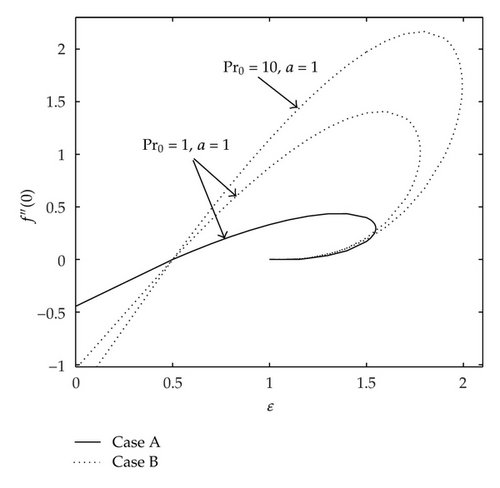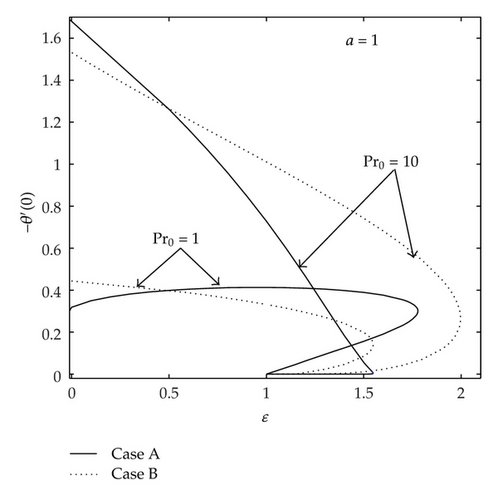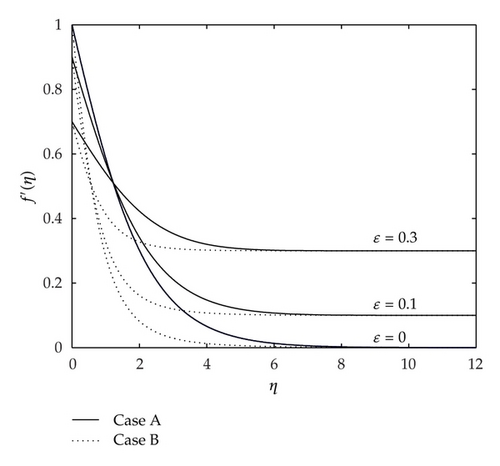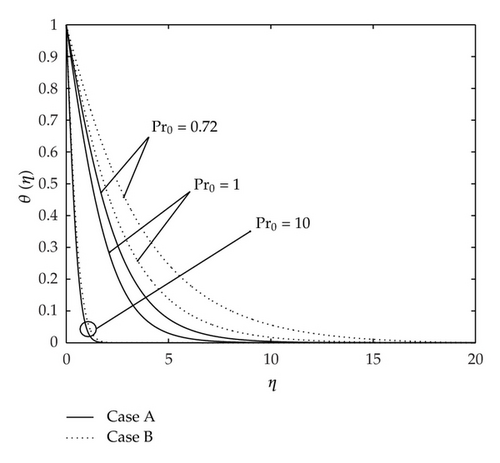Boundary Layer Flow and Heat Transfer with Variable Fluid Properties on a Moving Flat Plate in a Parallel Free Stream
Abstract
The steady boundary layer flow and heat transfer of a viscous fluid on a moving flat plate in a parallel free stream with variable fluid properties are studied. Two special cases, namely, constant fluid properties and variable fluid viscosity, are considered. The transformed boundary layer equations are solved numerically by a finite-difference scheme known as Keller-box method. Numerical results for the flow and the thermal fields for both cases are obtained for various values of the free stream parameter and the Prandtl number. It is found that dual solutions exist for both cases when the fluid and the plate move in the opposite directions. Moreover, fluid with constant properties shows drag reduction characteristics compared to fluid with variable viscosity.
1. Introduction
The problem of forced convection flow and heat transfer past a continuously moving flat plate is a classical problem of fluid mechanics and has attracted considerable interest of many researchers not only because of its many practical applications in various extrusion processes but also because of its fundamental role as a basic flow problem in the boundary layer theory of Newtonian and non-Newtonian fluid mechanics. It has been solved for the first time in 1961 by Sakiadis [1]. Thereafter, many solutions have been obtained for different situations of this class of boundary layer problems. The solutions for the cases when the mass transfer effect is included (fluid injection and fluid suction), chemical effects are considered, constant or variable surface temperatures, and other situations have been reported by Klemp and Acrivos [2], Abdelhafez [3], Hussaini et al. [4], Afzal et al. [5], Bianchi and Viskanta [6], Lin and Huang [7], Chen [8], Magyari and Keller [9], Afzal [10], Fang [11, 12], Sparrow and Abraham [13], and Weidman et al. [14], among others. However, it seems that the existence of dual solutions was reported only in the papers by Afzal et al. [5], Afzal [10], Fang [11, 12], Weidman et al. [14], Riley and Weidman [15], Fang et al. [16] and Ishak et al. [17].
The work by Pop et al. [18] belongs to the above class of problems, including the variation of fluid viscosity with temperature. The authors obtained similarity solutions considering that viscosity varies as an inverse function of temperature for two distinct Prandtl numbers 0.7 and 10.0. Exactly the same approach was taken by Elbashbeshy and Bazid [19] who reported results for Prandtl numbers 0.7 and 7.0. Pantokratoras [20] reconsidered the problem investigated earlier by Pop et al. [18] with the view to allow for the temperature-dependency on the Prandtl number. Fang [21] studied the influences of temperature-dependent fluid properties on the boundary layers over a continuously stretching surface with constant temperature. Andersson and Aarseth [22] presented a rigorous approach for proper treatment of variable fluid properties in the Sakiadis [1] flow problem. They presented a generalized similarity transformation which enables the analysis of the influence of temperature-dependent fluid properties. New and interesting results for water at atmospheric pressure were reported. The objective of the present paper is, therefore, to extend the paper by Andersson and Aarseth [22] to the case when the plate moves in a parallel free stream, a case that has not been considered before in the literature. Thus, following Andersson and Aaresth [22], the governing partial differential equations are transformed using similarity transformation to a system of ordinary differential equations, which is more convenient for numerical computations. The transformed nonlinear ordinary differential equations are solved numerically for certain values of the governing parameters using the Keller-box method. This method has been very successfully used by the present authors for other fundamental problems, see Ishak et al. [23] and Bachok et al. [24, 25].
2. Problem Formulation
3. Special Cases
3.1. Constant Fluid Properties (Case A)
3.2. Variable Viscosity (Case B)
4. Results and Discussion
The nonlinear ordinary differential equations (3.2) or (3.4), depending on the actual case considered, along with (3.3) subject to the boundary conditions (2.9) were solved numerically using a very efficient implicit finite-difference scheme known as Keller-box method, which is very well described in the book by Cebeci and Bradshaw [29]. In the general context, empirical correlations for all required fluid properties can be recast in terms of the dimensionless temperature θ(η) as defined in (2.5). The proper relations take then the forms like, for example (3.6). The generalized boundary value problem (2.7)–(2.9) is apparently a three-parameter problem of which the solution depends on T0, and ΔT ≡ Tw − T0, together with the Prandtl number Pr0 of the ambient fluid. The Prandtl number Pr0 is, however, uniquely related to the ambient temperature T0 and the boundary value problem (2.7)–(2.9) is actually a two-parameter problem in T0 (or Pr0) and ΔT. The present paper focuses on the effects of a temperature-dependent viscosity only, and the other fluid properties are assumed to be constant. First, however, the numerical solution of the classical problem (moving plate in a quiescent fluid, ε = 0) with constant fluid properties was computed for Prandtl number Pr0 = 0.7, 1, and 10. The characteristic surface gradients f′′(0) and θ′(0) are compared with Andersson and Aarseth [22] in Table 1 and serve primarily to validate the accuracy of the present solution technique. In order to illustrate the effect of a temperature-dependent viscosity, two different cases have been solved. The ambient fluid considered is water at temperature T0 = 278 K (5°C) and Pr0 = 10. The surface temperature is Tw = 358 K (85°C ) such that the operating temperature difference ΔT ≡ Tw − T0 is 80 K. Results for problem with constant fluid properties (Case A) are compared with those of the inversely linear viscosity variation (3.5), (3.6) (Case B). In (3.5), (3.6), we set θref = −0.25 for water at T0 = 278 K, as recommended by Ling and Dybbs [30]. The characteristic surface gradients f′′(0) and θ′(0) for Pr0 = 10 are obtained and compared with previously reported cases, and the comparison is shown in Table 2. It is seen from Tables 1 and 2 that the values of f′′(0) and θ′(0) obtained in this study are in very good agreement with the results reported by Andersson and Aarseth [22]. Therefore, it can be concluded that the developed code can be used with great confidence to study the problem considered in this paper.
| ε | Pr0 | a | Andersson and Aarseth [22] | Present results | ||
|---|---|---|---|---|---|---|
| −f′′(0) | −θ′(0) | −f′′(0) | −θ′(0) | |||
| 0 | 0.7 | 1 | 0.4437483 | 0.3492365 | 0.4437 | 0.3492 |
| 0 | 1 | 1 | — | — | 0.4437 | 0.4437 |
| 0 | 10 | 1 | — | — | 0.4437 | 1.6803 |
| ε | Pr0 | a | Andersson and Aarseth [22] | Present results | ||
|---|---|---|---|---|---|---|
| 0 | 10 | 1 | −f′′(0) | −θ′(0) | −f′′(0) | −θ′(0) |
| Case A | 0.443748 | 1.680293 | 0.4437 | 1.6803 | ||
| Case B | 1.300553 | 1.529151 | 1.3006 | 1.5292 | ||
| 0 | 1 | 1 | ||||
| Case A | — | — | 0.4437 | 0.4437 | ||
| Case B | — | — | 1.0381 | 0.3181 | ||
The variations of the reduced skin friction coefficient f′′(0) and reduced local Nusselt number −θ′(0) with the free stream parameter ε for both Cases (A) and (B) considered are shown in Figures 1 and 2, respectively. The values of f′′(0) are positive when ε > 0.5, while they are negative when ε < 0.5. Physically, a positive sign of f′′(0) implies that the fluid exerts a drag force on the plate and a negative sign implies the opposite. It can be seen from these figures that the existence of dual solutions when ε > 1 (the plate moves in the opposite direction of the free stream) with two branch solutions: upper and lower branches. The solution for both Cases (A) and (B) exists up to a critical value of ε (εc say). This value of εc increases as the Prandtl number Pr is increased, as shown in Figures 1 and 2. Further, it is evident from Figure 1 that the absolute value of f′′(0) is larger for Case B compared to Case A. Thus, fluid with constant properties shows drag reduction characteristics compared to fluid with variable viscosity. Moreover, the range of ε for which the solution exists is larger for Case B compared to Case A. It is worth mentioning that, for the case of constant fluid properties, Weidman et al. [14] have shown using a stability analysis that the upper branch solutions are stable, while the lower branch solutions are not. We expect that this observation is also true for the present problem.


The computed velocity profiles f′(η) and temperature profiles θ(η) are shown in Figures 3 and 4, respectively. One can see that the velocity profiles f′(η) in Figure 3 are substantially reduced near the moving surface for Case B as compared with Case A. The moving surface heats the adjacent fluid and thereby reduces its viscosity. Viscous diffusion of streamwise momentum from the surface towards the ambient is accordingly reduced in the inner part of the momentum boundary layer. The temperature profiles in Figure 4 show a higher temperature near the surface due to this reduced viscosity. Figures 3 and 4 show that the far field boundary conditions are approached asymptotically, which support the validity of the numerical results obtained. It is worth mentioning that the results presented in Figures 3 and 4 were produced with η∞ = 30, much larger than shown in these figures. This integration length is sufficiently long to satisfy f′′ → 0 and θ′ → 0 which is a necessary condition pointed out by Andersson and Aarseth [22].


5. Conclusions
In the present paper, we have studied numerically the problem of steady boundary layer flow with variable fluid properties on a moving flat plate in a parallel free stream. The governing partial differential equations are transformed using similarity transformation to a more convenient form for numerical computation. The transformed nonlinear ordinary differential equations were solved numerically using the Keller-box method. Numerical results for the skin friction coefficient and the local Nusselt number as well as the velocity and temperature profiles are illustrated in two tables and some graphs for various parameter conditions. Two special cases, namely, constant fluid properties and variable fluid viscosity, were considered. It was found that dual solutions exist when the plate and the free stream move in the opposite directions, for both cases considered. Moreover, fluid with constant properties show drag reduction characteristics compared to fluid with variable viscosity.
Acknowledgments
The authors wish to express their thanks to the reviewers for the valuable comments and suggestions. This work was supported by a research grant (UKM-GUP-2011-202) from the Universiti Kebangsaan Malaysia.




